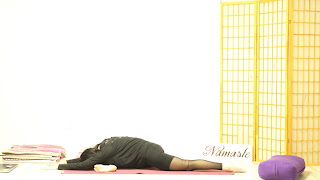How To Distinguish Differences in Tension and Compression in Yoga
How To Distinguish Differences in Tension and Compression in Yoga
I want to discuss the anatomical concepts of tension and compression in yoga practice. It is not uncommon for people to feel "something" while practicing yoga but to have trouble identifying what it is that they feel. When we feel restriction while holding a yoga pose, it is important to learn how to identify whether or not it is tension or compression that we are feeling. Knowing how to make this distinction can change your yoga practice entirely!
Why Is It Important to Know the Difference Between Tension and Compression in Yoga?
All of our bodies have a different life story, with different experiences, injuries and health histories. No two bodies have lived the same life and therefore cannot take the same shape in the same way. When you practice yoga, understanding the difference in tension and compression will help you to create a practice that is safe and effective. If you teach yoga, understanding the difference in tension and compression helps you realize that yoga poses are always evolving. We don't simply hit the pose and freeze there. The pose is constantly moving and changing within each individual body and the experience varies from one body to the next.
The pose is constantly moving and changing within each individual body and the experience varies from one body to the next.
Learning to identify and understand the differences in tension and compression will increase contentment during yoga practice and decrease opportunity for injury.
 |
| Original Image from Yoga Journal |
When You Feel Resistance in a Yoga Pose, It May Be From One of Two Things:
Tension: If the sensation you are feeling is coming from your muscles and/or ligaments being pulled or stretched apart from one another, this is tension. Tension can be in the form of a stretch but also a twist.
Compression: If the sensation you are feeling is coming from tissues being pressed into each other, this is compression. It could include the feeling of one bone rubbing on another.
What Happens When You Feel Tension During Yoga Practice?
You know you are feeling tension in yoga when the body seems to open up over time in the same pose. When you are feeling tension, and you are stretching your body in a way that is loving and gentle, the tension will decrease over time as the body's flexibility increases and starts to open in response to continued practice.
It is important not to press the body beyond its capacity. In Yin Yoga, we call this "finding our appropriate edge." Once you have found your edge in the pose, placing healthy stress (or tension) on the body will help the body open over time.
What Happens When You Feel Compression During Yoga Practice?
You know that you are feeling compression during yoga when the body hits a boundary that it cannot move beyond. Depending on how you are built in terms of skeletal structure, you may reach a place where one bone is hitting another bone and this will limit your range of motion. No amount of stretching changes skeletal structure.
When you feel compression, this does not mean something bad has happened. This does not mean you cannot take the yoga pose any further. It simply means you have to turn inwards and practice the yogic principle of contentment. You have to find acceptance that this is your version of the pose that you are in and be comfortable sitting with that. It should not be a painful process and if you are feeling sharp pain, you definitely want to back off of the pose.
It should not be a painful process and if you are feeling sharp pain, you definitely want to back off of the pose.
When you hit compression, you can always try to re-position yourself to move around the point of compression. You can also try a different variation of the pose. I see this often while teaching Yin Yoga. Many times I teach Yin Asana Sleeping Swan, pictured below:
 |
| Sleeping Swan, Yin Asana |
This can be a tough pose for many people as bone hits bone in this pose, range of motion is limited and compression is experienced. A great alternative to Sleeping Swan is Thread the Needle Pigeon or Reclining Pigeon, pictured below:
 |
| Reclining Pigeon, Yin Asana |
In these two postures, the body comes into the lower body takes on the same shape. It can be more accessible to practice the pose in a reclined position so that compression is less likely and can be mitigated. If it's enough of a stretch, the left foot can remain on the floor while the outside of the ankle comes to the top of the left knee/left thigh. If someone is not feeling a stretch with the left foot grounded, they can interlace the fingers behind the left leg and use the hands to begin to pull the left knee in towards the face, deepening the hip opener.
Join Our Yin Yoga Teacher Training Online to Learn More About Tension and Compression
To learn more about tension and compression, please join our Yin Yoga Teacher Training Online that includes 5 yin practices, 40+ yin asana poses, lectures, playlists, videos and more. This Yin Yoga Teacher Certification is approved for Yoga Alliance Continuing Education, 25 Hours. Be sure to also check out our Online Restorative Yoga Teacher Training and our Online 200 Hour Yoga Teacher Training Certification.




Comments
Post a Comment